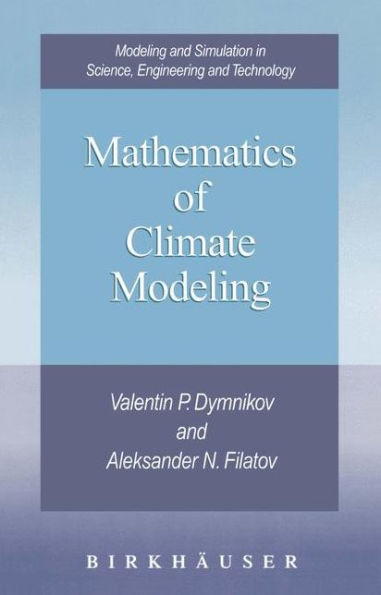5
1

Mathematics of Climate Modeling
264
by Valentin P. Dymnikov, Aleksander N. Filatov
Valentin P. Dymnikov

Mathematics of Climate Modeling
264
by Valentin P. Dymnikov, Aleksander N. Filatov
Valentin P. Dymnikov
Paperback(1997)
$169.99
-
PICK UP IN STORECheck Availability at Nearby Stores
Available within 2 business hours
Related collections and offers
169.99
In Stock
Overview
The present monograph is dedicated to a new branch of the theory of climate, which is titled by the authors, "Mathematical Theory of Climate. " The foundation of this branch is the investigation of climate models by the methods of the qUalitative theory of differential equations. In the Russian edition the book was named "Fundamentals of the Mathematical Theory of Climate. " Respecting the recommenda tions of Wayne Yuhasz (we are truly grateful to him for this advice), we named the English edition of the book "Mathematics of Climate Modelling. " This title appears to be more appropriate, since the constructive results of the theory are at present preliminary and have not been fully tested with experiments in climate modelling. This branch of science is yet developing and its practical results will be obtained only in the near future. Nevertheless, we want to keep the terminology which we have used in the introduction to the Russian edition of the book, since the authors hope that this term will be accepted by the scientific community for identification of a given branch of climate theory. On preparing the English edition, new ideas were established con necting some significant new research results obtained by the author. We are deeply grateful to G. Marchuk for continual encourage ment of this scientific enterprise and fruitful discussions, to our young colleagues A. Gorelov, E. Kazantsev, A. Gritsun, and A.

Product Details
| ISBN-13: | 9781461286745 |
|---|---|
| Publisher: | Birkhäuser Boston |
| Publication date: | 10/14/2011 |
| Series: | Modeling and Simulation in Science, Engineering and Technology |
| Edition description: | 1997 |
| Pages: | 264 |
| Product dimensions: | 6.10(w) x 9.25(h) x 0.02(d) |
Table of Contents
1. Dynamical Systems. Attractors, Invariant Measures.- 1.1 Metric Spaces. Compactness.- 1.2 Dynamical Systems. Main Properties.- 1.3 Invariant Sets.- 1.4 Classification of Motions.- 1.5 Recurrence of Domains.- 1.6 Measure. Krylov-Bogolyubov Theorem.- 1.7 Dynamical Systems with Invariant Measure.- 1.8 Nonlinear Dissipative Systems.- 1.9 Inertial Manifolds of Dissipative Systems.- 2. Non-Autonomous Dissipative Systems, their Attractor and Averaging.- 2.1 Introduction.- 2.2 Processes and their Attractors. Kernel of Processes, Section of Kernel.- 2.3 Families of Processes and their Attractors.- 2.4 Family of Processes and Semigroups.- 2.5 Averaging of Nonlinear Dissipative Systems. Closeness between Attractors of Original and Averaged Systems.- 2.6 On Closeness of Solutions of Original and Averaged Nonlinear Dissipative Systems on Infinite Time Interval.- 3. Analysis of Barotropic Model.- 3.1. Existence of Global Attractor.- 3.2 Estimate of Dimension of Attractor.- 3.3 Statistical Solutions and Invariant Measures on Attractor.- 3.4 Estimate of Attractor Dimension with Respect to Orography.- 3.5 Galerkin Approximations.- 3.6 Existence of Inertial Manifold.- 4. Discretization of Systems Possessing Attractor.- 4.1 Discretization of Systems Possessing Inertial Manifolds.- 4.2 Time-Space Discretization of Systems Possessing Attractor.- 4.3 Globally Stable Difference Schemes for Barotropic Vorticity Equation.- 5. Numerical Study of Structure of Attractor Generated by Barotropic Equations on Sphere.- 5.1 Equations and Parameters of Model. Methods of Solving of Stationary and Nonstationary Problems.- 5.2 Statistical Stationary Solution and Stationary Points.- 5.3 Lyapunov Exponents and Attractor Dimension.- 5.4 Analysis of Analytical Estimates of Attractor Dimension of Barotropic Atmospheric Equations.- 6. Two-Layer Baroclinic Model.- 6.1 Two-Layer Baroclinic Model.- 6.2 Estimate of Attractor Dimension.- 6.3 Numerical Investigation of Attractor. Characteristics of Two-Layer Baroclinic Model.- 7. Investigation of Structure of Climate Attractors by Observed Data Series.- 7.1. Correlation Dimension of Attractor.- 7.2. Calculation of Lyapunov Exponents.- 7.3 Statistically Independent Degrees of Freedom and Attractor Dimension.- 8. Regimes of Atmosphere Circulation.- 8.1 Definition of Atmosphere Circulation Regimes.- 8.2 Dynamical Theory of Two-Regime Barotropic Circulation.- 8.3. Statistical Theory of Two-Regime Barotropic Circulation.- 8.4 S-Regimes of Atmosphere Circulation.- 9. Solvability of Ocean and Atmosphere Models.- 9.1 Introduction.- 9.2 Solvability of Ocean and Atmosphere Models in Bounded Domains.- 9.3 Solvability of Ocean and Atmosphere Models on Sphere in p-System of Coordinates.From the B&N Reads Blog
Page 1 of
